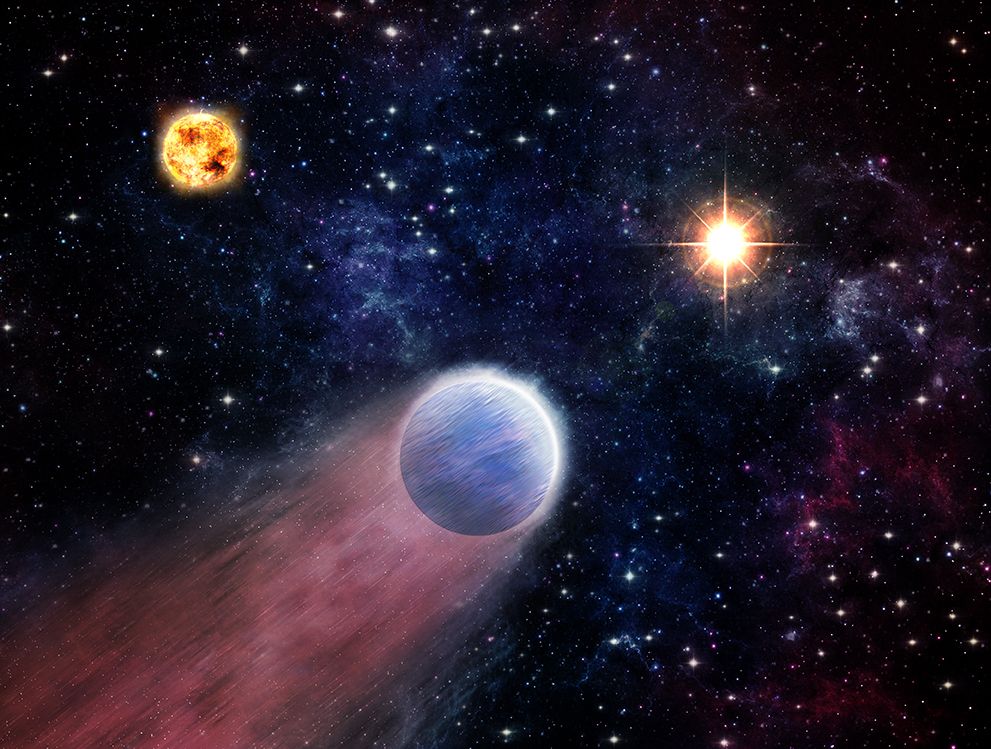Black Holes Shape Some Alien Planets' Destinies

Monster black holes near the center of our Milky Way galaxy may have transformed "mini-Neptune" exoplanets into rocky super-Earths, new research shows.
Supermassive black holes are thought to reside at the centers of most, if not all, large galaxies. They gobble up surrounding matter and, in turn, generate bright flares of X-ray and ultraviolet radiation.
The new findings suggest that these powerful bursts could strip nearby exoplanets of their thick, gaseous atmosphere, leaving behind a bare, rocky core. These rocky bodies would likely be heavier than Earth, making them so-called super-Earths, according to a statement from the Harvard-Smithsonian Center for Astrophysics (CfA). [The Strangest Black Holes in the Universe]
"It's pretty wild to think of black holes shaping the evolutionary destiny of a planet, but that very well may be the case in the center of our galaxy," lead study author Howard Chen, a postdoctoral candidate in the Northwestern University Department of Earth and Planetary Sciences, said in the statement.
In the study, the researchers examined the environment surrounding Sagittarius A*, the 4-million-solar-mass supermassive black hole that lurks in the center of our galaxy, around 25,000 light-years from Earth.
"We wondered what these outbursts from Sagittarius A* would do to any planets in its vicinity," study co-author John Forbes, of the CfA, said in the statement. "Our work shows the black hole could dramatically change a planet's life."
Specifically, the researchers studied the effect that the high-energy radiation from Sagittarius A* has on exoplanets that are located less than 70 light-years from the black hole and have masses somewhere between Earth's and Neptune's. These exoplanets can be known as "super-Earths" because they are bigger than our rocky, oceanic Earth, or "mini-Neptunes" because they are smaller than the cold, gas-shrouded Neptune.
Sign up for the Live Science daily newsletter now
Get the world’s most fascinating discoveries delivered straight to your inbox.
The new study shows that the high-energy radiation from Sagittarius A* could blow away a large amount of the thick, gaseous atmosphere of Neptune-like planets near the black hole and leave behind rocky super-Earths, according to the statement.
"These super-Earths are one of the most common types of planet that astronomers have discovered outside our solar system," study co-author Avi Loeb, of the CfA, said in the statement. "Our work shows that in the right environment they might form in exotic ways."
In fact, the recent findings suggest that this process may be the most common way in which rocky super-Earths form near the center of the Milky Way, the researchers said.
It is possible that some of these planets may be found in the habitable zone of a star, where temperatures are just right for liquid water, and perhaps life, to exist. However, it would be difficult for any life to arise in the challenging environment of the galactic center, due to damaging supernova explosions, high-energy gamma-rays and additional black-hole outbursts, which could completely erode a planet's atmosphere, according to the study.
Furthermore, a passing star could cause gravitational disruptions that would tear the planet away from its life-sustaining host star. Such disruptions may be more common in areas packed with stars, such as Sagittarius A*, the researchers said.
"It is generally accepted that the innermost region of the Milky Way is not favorable for life," Loeb said. But "even though the deck seems stacked against life in this region, the likelihood of panspermia, where life is transmitted via interplanetary or interstellar contact, would be much more common in such a dense environment. This process might give life a fighting chance to arise and survive."
Detecting exoplanets near the core of the Milky Way is challenging due to its distance from Earth, abundance of stars and thick clouds of dust and gas that block light. However, larger, next-generation, ground-based telescopes — such as the European Extremely Large Telescope — could help to overcome these challenges by searching for "transits," in which an exoplanet orbits in front of its star.
Another method that could prove useful for detecting these elusive exoplanets involves searching for stars with traces of unusual elements in their atmospheres that would indicate that the star has migrated away from the center of the galaxy, the researchers said in the statement.
The new work was detailed Feb. 22 in The Astrophysical Journal Letters. The full article text is available on arXiv.org.
Follow Samantha Mathewson @Sam_Ashley13. Follow us @Spacedotcom, Facebook and Google+. Original article on Space.com.














